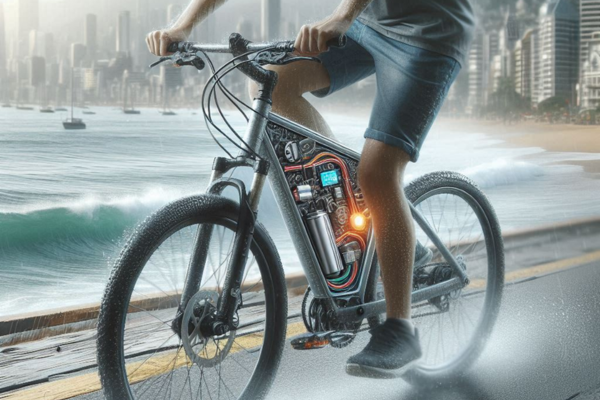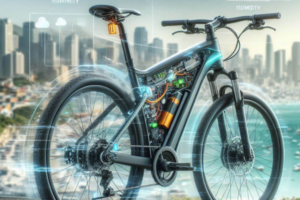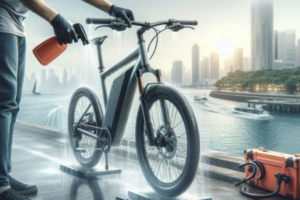🌧️ Understanding the Invisible Energy Drain of Humid Weather
Electric bicycles are celebrated for their efficiency, but that efficiency can be easily compromised by one subtle, persistent factor: humidity. While riders often prepare for rain or mud, few fully realize how ambient moisture in the air can affect the energy performance of their e-bike — even without a single raindrop.
Humid weather is common in coastal cities, tropical climates, and even during seasonal transitions in temperate zones. It creates a persistent layer of moisture on every surface, infiltrates electrical systems, and alters how your bicycle consumes and conserves energy. Unlike a thunderstorm, humidity doesn’t announce itself. It slowly wears down your components, increases resistance, and decreases the effectiveness of your battery — without you noticing, until your range suddenly isn’t what it used to be.
⚙️ What Humidity Does to Your E-Bike’s Energy Performance
Your electric bicycle is a system of mechanical and electrical components designed to work in harmony. But humidity disrupts this harmony in several ways, each contributing to a measurable loss in energy efficiency.
- Electrical conductivity increases: Moisture allows electricity to travel along unintended paths, leading to minor energy leaks, interference, and voltage drops.
- Battery efficiency drops: High humidity accelerates internal corrosion and reduces the rate at which a battery can safely discharge or charge. This leads to overheating and shortened range.
- Friction builds up: Moist air mixes with dust and grit to form a sticky residue on chains, sprockets, and derailleurs, making the drivetrain heavier and harder to move efficiently.
- Brake drag worsens: Disc brakes and pads are more likely to retain a thin film of rust or water vapor, creating minor resistance that requires more motor power to overcome.
- Tire pressure fluctuates: Changes in ambient temperature and humidity can lower PSI levels, which increases rolling resistance and decreases range.
Each of these factors might seem small — but they add up. Riders in humid areas often lose 10–20% of their expected range without understanding why. And over time, components wear faster, maintenance costs rise, and the ride becomes less smooth and satisfying.
💡 A Powerful Insight
“Humidity doesn’t roar or crash — but it quietly steals your power. Energy loss begins where moisture settles and care is forgotten.”
Understanding how humidity affects your e-bike is the first step. The good news? There are clear, practical ways to fight back — and even regain lost range. In the next sections, we’ll dive into smart maintenance techniques, technical upgrades, and real stories from riders who faced the challenge of riding in humid climates — and won.
🛠️ Weekly Maintenance to Protect Energy in Humid Weather
Combatting the effects of humidity doesn’t require expensive tools or professional servicing — it starts with simple, consistent weekly maintenance. When done with intention, this routine can preserve battery range, reduce wear on mechanical parts, and extend your e-bike’s life by years.
🔧 Humid Weather Maintenance Checklist
Here’s a proven weekly maintenance routine designed for riders who live in humid, coastal, or tropical areas:
- ✅ Wipe down your bike after each ride: Use a clean microfiber cloth to remove moisture, especially from the battery housing, display screen, motor casing, chainstay, and brake components.
- ✅ Clean and re-lubricate your chain: Use a degreaser to remove sticky residue caused by moist air and then apply a wet-condition chain lube to prevent corrosion and reduce friction.
- ✅ Inspect brake discs and pads: Look for rust film or moisture buildup. Clean rotors with isopropyl alcohol and ensure pads are dry and free of grit.
- ✅ Check tire pressure: Humidity often coincides with temperature shifts that affect PSI. Underinflated tires increase drag and reduce energy efficiency — so top off weekly as needed.
- ✅ Check battery terminals and charging port: Use compressed air or a soft brush to remove any dust or condensation. Ensure the connectors are dry before and after charging.
- ✅ Store your bike in a ventilated, dry space: Avoid closed plastic covers or tightly sealed sheds where humidity gets trapped. A shaded, well-ventilated indoor area is ideal.
This routine takes no more than 15–20 minutes and can dramatically reduce the subtle, constant energy losses caused by humid air. The result? A smoother ride, more responsive motor, and longer-lasting charge.
📊 Comparative Table: Dry vs. Humid Weather Maintenance
| Maintenance Task | Dry Weather | Humid Weather |
|---|---|---|
| Chain lubrication | Every 2–3 weeks | Weekly or after wet rides |
| Battery terminal check | Monthly | Weekly |
| Brake rotor cleaning | Monthly | Every 7–10 days |
| Tire pressure adjustment | Bi-weekly | Weekly or post-rain |
💬 Energy Tip
“In humid weather, the smallest effort matters. Wipe, check, lube — and your energy stays where it belongs: on the road.”
You don’t need a mechanic — just a cloth, some awareness, and a habit. Weekly care creates efficiency not only in your bike, but in your routine as a rider. Let it be part of your rhythm, like checking the tide before a coastal ride.
🌍 Real Story: Riding Through Humidity with Smarter Habits
Ana is a daily commuter in Recife, Brazil — a coastal city known for its beautiful bike paths and high humidity. When she bought her electric bicycle, she expected freedom from traffic and a reliable 40 km range per charge. But within the first two months, her range dropped to 30 km. Her chain was noisy, her motor didn’t feel as strong, and charging took longer than usual.
Initially, Ana blamed the battery. But after visiting a technician, she discovered the real issue was moisture and salt buildup. Her drivetrain had developed subtle rust. Her brake discs were dragging slightly due to oxidation. And her charging port had light corrosion that interfered with power flow.
She started a simple routine: drying her bike after every ride, storing the battery indoors, applying wet-condition chain lube weekly, and cleaning the brake rotors with alcohol. Within two weeks, she recovered 8 km of range. Her bike felt responsive again. And for the first time, she understood how riding in humid weather isn’t just about the ride — it’s about how you care before and after it.
Her story shows what many riders eventually learn: energy efficiency starts at home, not on the road.
✅ Small Upgrades That Make a Big Difference in Humidity
Beyond routine maintenance, certain upgrades can dramatically improve how your e-bike performs in humid environments. These aren’t luxury add-ons — they’re smart investments that protect your energy and extend your battery’s health.
- 🔩 Stainless steel or anti-rust drivetrain components: Salt and moisture accelerate corrosion. Replacing vulnerable bolts, chainrings, and screws with corrosion-resistant ones ensures smoother performance and less energy waste.
- 🛢️ High-performance wet-condition lubricants: Look for lubricants with PTFE or ceramic coatings that bond to the chain and repel moisture better than standard oils.
- ⚡ Dielectric grease for connectors: Applying a small amount to battery terminals and charging ports creates a barrier against humidity while maintaining electrical contact.
- 🧼 Protective frame sprays: Water-repelling sprays or nano-coatings help shield your frame and sensitive parts from condensation and rust buildup.
- 🚲 Mudguards and chain guards: These physical barriers reduce the contact of salt spray or puddle splash with critical components, keeping your energy system cleaner.
Each of these upgrades adds a layer of protection. More importantly, they reduce the small inefficiencies that force your motor to work harder. In humid regions, reducing drag, friction, and voltage interference means gaining distance and confidence.
💬 Encouraging Insight
“Sometimes, riding farther doesn’t mean upgrading your bike — it means upgrading your habits and giving your bike what it needs to thrive in your world.”
Efficiency in humid environments isn’t about perfection — it’s about awareness. With just a few smart adjustments, you can ride through coastal mornings and tropical evenings without losing your charge to the air around you. And the best part? You’ll feel the difference in every pedal stroke.
🚫 Common Mistakes That Drain Your Battery in Humid Weather
Even experienced electric bicycle riders often fall into habits that unintentionally reduce energy efficiency — especially when it comes to humid climates. The effects of moisture, salt, and temperature swings are subtle, but the wrong behaviors can quietly shorten your range, increase wear, and reduce battery lifespan.
Let’s look at the most common mistakes riders make — and how you can easily avoid them:
- ❌ Skipping post-ride wipe-downs: Even if it didn’t rain, humid air deposits moisture on every surface. Leaving it there overnight allows corrosion and friction to build.
- ❌ Using the wrong lubricant: Dry-condition lubes don’t last in humid air. They break down quickly and leave your drivetrain unprotected, which leads to rust and energy-wasting drag.
- ❌ Charging the battery while still damp: After a ride, your battery or port might be slightly wet. Charging without drying it first increases condensation risk and may damage cells or connectors.
- ❌ Storing your e-bike under a sealed cover: While it may seem protective, plastic or vinyl covers trap humidity inside. Instead of shielding your bike, they create a rust-prone microclimate.
- ❌ Ignoring brake noise or slight drag: A squeaky or sticky brake often means surface corrosion or misalignment — which forces your motor to use more energy with every rotation.
Most of these mistakes are easily fixed with small, consistent habits. And when you correct them, your energy efficiency improves immediately — giving you longer rides, smoother starts, and more responsive performance.
📋 Weekly Energy-Saving Checklist
Here’s a quick checklist you can follow once or twice a week. Think of it as a 15-minute investment in the longevity of your ride and the strength of your battery:
- ✅ Wipe down the frame, battery case, chain, and brake discs after every ride.
- ✅ Apply wet-condition chain lube weekly (more often if exposed to sea air).
- ✅ Use compressed air or a dry brush to clean battery terminals and connectors.
- ✅ Check tire pressure and top up if needed — low PSI drains battery power.
- ✅ Listen for brake noise and clean rotors with alcohol if needed.
- ✅ Store the e-bike and battery in a cool, dry, ventilated location.
These steps aren’t difficult. In fact, once they become routine, they’re empowering. They turn you into an expert on your own machine — and give you back the power that the weather tries to take away.
💡 Efficiency Mindset
“Every time you care for your e-bike, you’re not just cleaning metal — you’re clearing the path for energy to flow freely.”
In humid environments, neglect is expensive — not in money, but in energy. But with just a few adjustments, you can keep your ride efficient, powerful, and protected. The tools are simple. The results are meaningful.
❓ Frequently Asked Questions (FAQs)
Can humidity really affect battery range even without rain?
Yes. High humidity causes internal condensation, corrosion, and interference in battery terminals and connections — all of which reduce battery performance. Even in dry-looking conditions, moisture in the air can disrupt efficiency silently and consistently.
Is it necessary to remove the battery every day?
Not always, but it’s highly recommended if you live in a humid or coastal area and store your bike outdoors or in a non-ventilated space. Removing the battery and storing it indoors protects it from ambient moisture and extends its lifespan.
What type of lubricant should I use for the chain?
Use a high-quality wet-condition or marine-grade chain lubricant. Look for formulas with PTFE or ceramic particles — they offer better moisture resistance and reduce drivetrain friction, especially in damp environments.
How often should I clean the connectors and battery port?
At least once a week if you ride in humid areas. Use a dry brush or compressed air to clear out dust and moisture. Avoid spraying liquid cleaners into connectors unless specifically designed for electronics.
Do fenders or guards help with humidity?
Absolutely. Fenders, mudguards, and chain covers reduce the amount of moisture and debris hitting sensitive areas. They’re especially effective in preventing puddle splash and reducing salt exposure near the drivetrain and brakes.
💬 Final Thoughts
Humidity is not your enemy — it’s just part of the environment. And just like the wind or the terrain, it teaches us to adapt. When you understand how it affects your electric bicycle, you gain the power to make smarter choices — not just for maintenance, but for energy conservation, safety, and peace of mind.
You don’t need expensive upgrades or a technical background to ride better in humid weather. All you need is awareness, intention, and a little routine. With care and knowledge, your e-bike will not just survive — it will thrive in any climate.
🌟 Your Experience Matters
Do you ride in a humid city? Have you noticed how it affects your battery life or motor performance? Maybe you have a tip or habit that’s worked wonders for you?
We’d love to hear your story. Drop a comment below with your experience, advice, or questions. Sharing your insight could help another rider stay strong, safe, and fully charged.
Together, we build a community of smart, resilient cyclists — ready to face any weather with clarity and confidence.



